The global food service equipment market, including pizza shop equipment, was valued at USD 38.4 billion in 2023 and is projected to reach USD 58.4 billion by 2032. This growth is driven by the rising demand for energy-efficient and sustainable equipment, as well as technological advancements like AI and IoT integration. As the market evolves, selecting the right equipment is crucial for business buyers to stay competitive and efficient.
Table of Contents:
Understanding the Pizza Shop Equipment Market
Essential Pizza Shop Equipment for New Businesses
Factors to Consider When Choosing Pizza Shop Equipment
Maintenance and Longevity of Pizza Shop Equipment
Future Trends in Pizza Shop Equipment
Making the Final Decision on Pizza Shop Equipment
Understanding the Pizza Shop Equipment Market
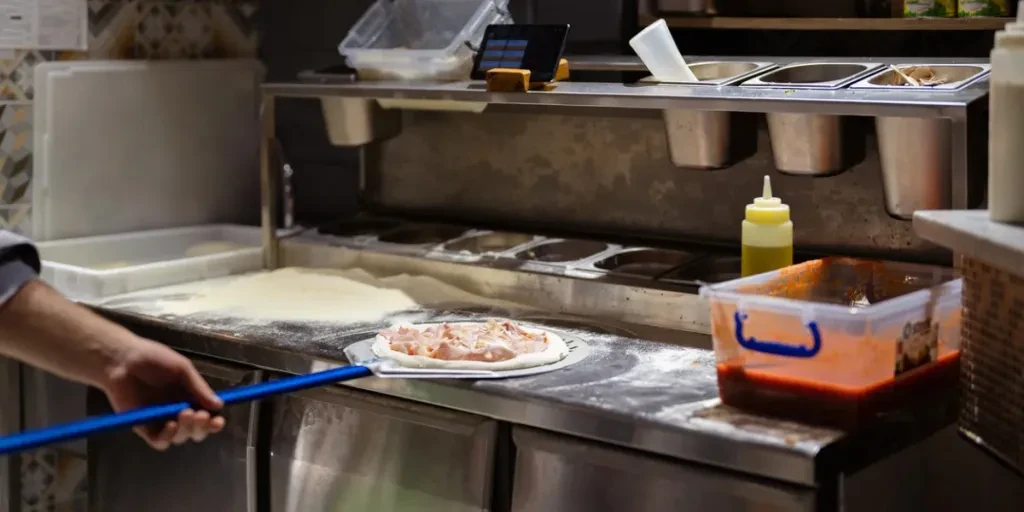
Current Market Dynamics
The global food service equipment market, which includes pizza shop equipment, reached a valuation of USD 38.4 billion in 2023. This market is projected to grow at a CAGR of 4.77%, reaching USD 58.4 billion by 2032. The growth is driven by the rising demand for energy-efficient and sustainable equipment, as well as the expansion of the food service sector, particularly in emerging markets. The increasing popularity of dining out and the proliferation of quick-service restaurants (QSRs) are also significant contributors to this growth.
Energy efficiency and sustainability are becoming critical factors in the market. Regulatory authorities are setting higher environmental criteria, pushing manufacturers to innovate and produce more eco-friendly equipment. For instance, the ENERGY STAR program by the U.S. Environmental Protection Agency (EPA) reports that food service equipment with the ENERGY STAR symbol can save operators around USD 5,300 or 340 MMBTU per year. This trend is expected to continue, further driving the demand for advanced pizza shop equipment.
The market is also influenced by technological advancements, such as the integration of artificial intelligence (AI) and the Internet of Things (IoT) in kitchen equipment. These technologies help reduce staff shortages and improve operational efficiency by providing real-time monitoring and control. The adoption of smart and connected kitchen technology is expected to enhance food safety and operational efficiency, making it a key trend in the pizza shop equipment market.
Key Players and Suppliers
The competitive landscape of the pizza shop equipment market includes several major players. Companies like AB Electrolux, Ali Group s.r.l. a socio unico, Alto-Shaam Inc., Cambro Manufacturing, and The Middleby Corporation are prominent in this sector. These companies are engaged in research and development to introduce innovative, energy-efficient, and technologically advanced products. For example, The Middleby Corporation’s acquisition of Colussi Ermes in 2022 expanded its portfolio of automated washing solutions, enhancing its market position.
These key players are also expanding their geographic footprint and strengthening their distribution networks to enter emerging markets. Strategic mergers and acquisitions are common, allowing companies to broaden their product portfolios and incorporate advanced technologies like IoT connectivity and AI-driven automation. This competitive environment drives continuous innovation and improvement in pizza shop equipment.
Challenges in the market include the high cost of innovative equipment, which can be a substantial obstacle for small to medium-sized organizations. Older establishments may struggle to upgrade existing systems due to the complexity of integrating new technology. However, the development of cost-effective solutions for small enterprises is expanding market growth. The focus on products that meet the demands of fast-casual and quick-service restaurant segments is also strengthening market expansion.
Emerging Trends in Pizza Shop Equipment
One of the key trends in the pizza shop equipment market is the increasing emphasis on energy efficiency and sustainability. The awareness about energy consumption and eco-friendly initiatives encourages consumers to adopt energy-efficient appliances. For instance, the global market for food service equipment is influenced by regulations and norms aimed at reducing greenhouse gas emissions. This trend is expected to drive the demand for energy-efficient pizza shop equipment.
Another emerging trend is the utilization of AI and IoT in kitchen equipment. These technologies help address labor shortages and improve operational efficiency by providing real-time monitoring and control. For example, smart ovens and refrigerators can adjust their settings based on usage patterns, reducing energy consumption and improving food safety. The adoption of these technologies is expected to grow, further enhancing the efficiency and sustainability of pizza shop operations.
The market is also witnessing a shift towards automation to improve productivity and reduce labor costs. Automated dough preparation equipment, for instance, can handle large volumes of dough with minimal human intervention, ensuring consistency and quality. This trend is particularly relevant in regions with high labor costs, where automation can significantly improve operational efficiency. The integration of robotics in pizza preparation and cooking processes is another area of growth, offering potential for further innovation and efficiency improvements.
Essential Pizza Shop Equipment for New Businesses
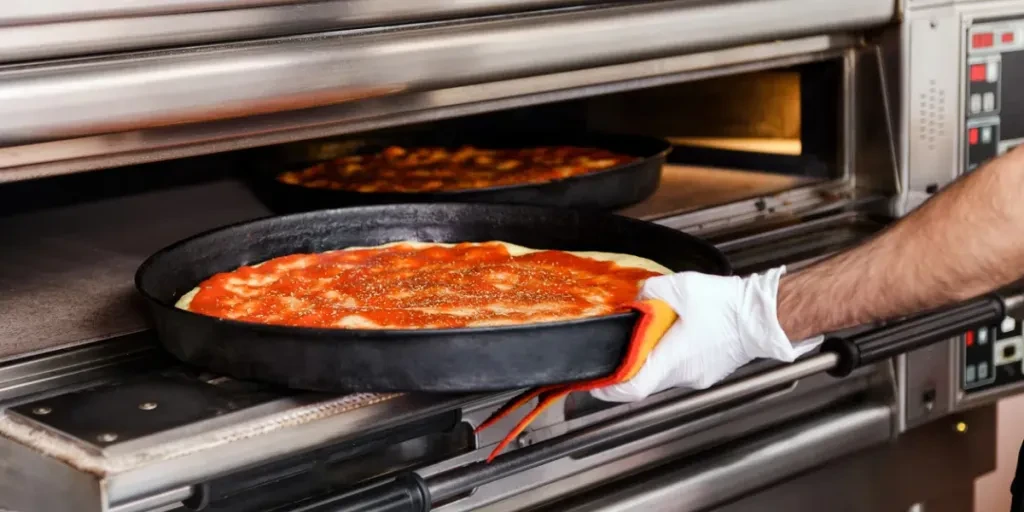
Commercial Pizza Ovens
Commercial pizza ovens are a cornerstone of any pizza shop, and their market is expected to grow significantly. The global market for bakery processing equipment, which includes pizza ovens, is projected to reach USD 24.5 billion by 2030, growing at a CAGR of 6.3%. This growth is driven by the increasing demand for high-quality, energy-efficient ovens that can handle large volumes of pizza with consistent results.
There are various types of commercial pizza ovens, including deck ovens, conveyor ovens, and wood-fired ovens. Deck ovens are popular for their ability to produce a traditional, crispy crust, while conveyor ovens are favored for their efficiency and consistency in high-volume settings. Wood-fired ovens, on the other hand, are known for imparting a unique flavor to the pizza, making them a popular choice for gourmet pizza shops. The choice of oven depends on the specific needs and preferences of the business.
Technological advancements are also playing a significant role in the development of commercial pizza ovens. For instance, smart ovens equipped with IoT capabilities can monitor and adjust cooking parameters in real-time, ensuring optimal results. These ovens can also provide data on usage patterns, helping operators optimize their energy consumption and maintenance schedules. The integration of AI in pizza ovens is another emerging trend, with AI-driven ovens capable of learning and adapting to different cooking styles and preferences.
Dough Preparation Equipment
Dough preparation equipment is essential for ensuring the consistency and quality of pizza dough. The global market for bakery processing equipment, which includes dough mixers and blenders, is expected to grow at a CAGR of 6.2% over the next seven years. This growth is driven by the increasing demand for high-quality dough preparation equipment that can handle large volumes with minimal human intervention.
Key equipment in this category includes dough mixers, dough dividers, and dough sheeters. Dough mixers are designed to mix ingredients thoroughly, ensuring a consistent dough texture. Dough dividers are used to portion the dough into equal sizes, while dough sheeters roll the dough to the desired thickness. These machines are essential for maintaining consistency and quality in pizza production, especially in high-volume settings.
Technological advancements are also influencing the development of dough preparation equipment. For instance, automated dough mixers equipped with IoT capabilities can monitor and adjust mixing parameters in real-time, ensuring optimal results. These mixers can also provide data on usage patterns, helping operators optimize their energy consumption and maintenance schedules. The integration of AI in dough preparation equipment is another emerging trend, with AI-driven mixers capable of learning and adapting to different dough recipes and preferences.
Refrigeration Units
Refrigeration units are crucial for maintaining the freshness and quality of ingredients in a pizza shop. The global market for food service equipment, which includes refrigeration units, is expected to reach USD 58.4 billion by 2032, growing at a CAGR of 4.77%. This growth is driven by the increasing demand for energy-efficient and sustainable refrigeration solutions.
There are various types of refrigeration units used in pizza shops, including walk-in coolers, reach-in refrigerators, and under-counter refrigerators. Walk-in coolers are ideal for storing large quantities of ingredients, while reach-in refrigerators are suitable for quick access to frequently used items. Under-counter refrigerators are compact and can be placed under prep tables, providing convenient access to ingredients during food preparation.
Technological advancements are also playing a significant role in the development of refrigeration units. For instance, smart refrigerators equipped with IoT capabilities can monitor and adjust temperature settings in real-time, ensuring optimal storage conditions. These refrigerators can also provide data on usage patterns, helping operators optimize their energy consumption and maintenance schedules. The integration of AI in refrigeration units is another emerging trend, with AI-driven refrigerators capable of learning and adapting to different storage requirements and preferences.
Pizza Prep Tables
Pizza prep tables are essential for efficient and organized pizza preparation. The global market for food service equipment, which includes pizza prep tables, is expected to grow significantly in the coming years. This growth is driven by the increasing demand for high-quality, durable, and efficient prep tables that can streamline the pizza preparation process.
Pizza prep tables typically feature a refrigerated base for storing ingredients and a work surface for assembling pizzas. They are designed to keep ingredients fresh and within easy reach, improving efficiency and reducing preparation time. Some prep tables also come with built-in cutting boards, ingredient bins, and other accessories to further enhance their functionality.
Technological advancements are also influencing the development of pizza prep tables. For instance, smart prep tables equipped with IoT capabilities can monitor and adjust temperature settings in real-time, ensuring optimal storage conditions for ingredients. These tables can also provide data on usage patterns, helping operators optimize their energy consumption and maintenance schedules. The integration of AI in pizza prep tables is another emerging trend, with AI-driven tables capable of learning and adapting to different preparation styles and preferences.
Slicers and Cutters
Slicers and cutters are essential tools for any pizza shop, ensuring consistent and precise slicing of ingredients and pizzas. The global market for food service equipment, which includes slicers and cutters, is expected to grow significantly in the coming years. This growth is driven by the increasing demand for high-quality, durable, and efficient slicing and cutting tools.
There are various types of slicers and cutters used in pizza shops, including manual and automatic slicers, pizza cutters, and dough cutters. Manual slicers are suitable for small to medium-sized operations, while automatic slicers are ideal for high-volume settings. Pizza cutters are designed to slice pizzas into equal portions, while dough cutters are used to portion dough into equal sizes. These tools are essential for maintaining consistency and quality in pizza production.
Technological advancements are also influencing the development of slicers and cutters. For instance, automatic slicers equipped with IoT capabilities can monitor and adjust slicing parameters in real-time, ensuring optimal results. These slicers can also provide data on usage patterns, helping operators optimize their energy consumption and maintenance schedules. The integration of AI in slicers and cutters is another emerging trend, with AI-driven tools capable of learning and adapting to different slicing and cutting requirements and preferences.
Factors to Consider When Choosing Pizza Shop Equipment
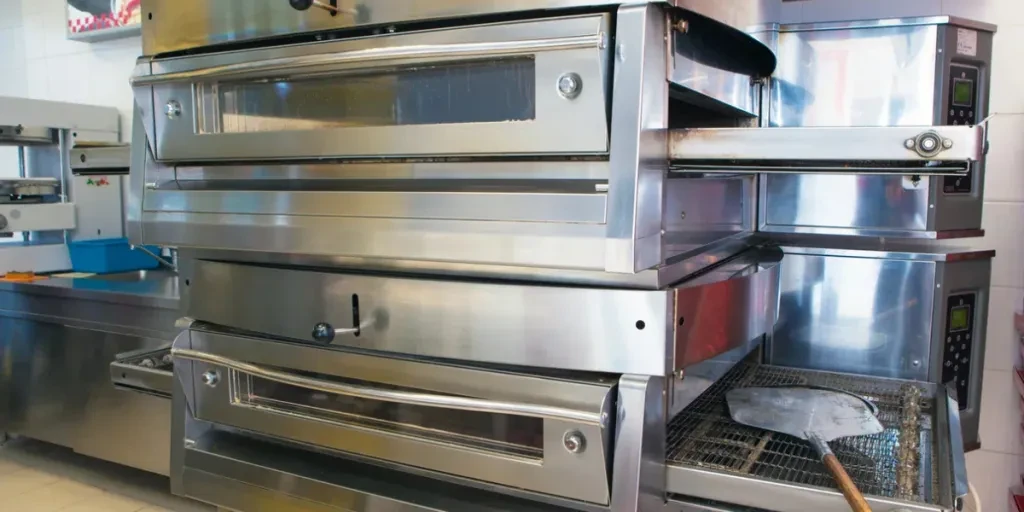
Equipment Size and Space Requirements
When selecting pizza shop equipment, the size and space requirements are crucial. The dimensions of the equipment must fit within the available kitchen space without causing congestion. For instance, a commercial pizza oven can range from 48 to 60 inches in width, which necessitates careful planning of kitchen layout. Additionally, the height and depth of the equipment should be considered to ensure it does not obstruct other kitchen operations.
Space optimization is essential for efficient workflow in a pizza shop. Equipment like dough mixers, which can be as large as 30 inches in diameter, need to be strategically placed. This placement should allow for easy access and movement around the kitchen. Moreover, the equipment should be positioned to facilitate a logical flow from preparation to cooking to serving, minimizing unnecessary movement and time wastage.
Consideration of future expansion is also important when planning equipment size and space. If the pizza shop plans to increase its menu or volume, the equipment should be scalable. For example, modular refrigeration units can be added as needed without requiring a complete overhaul of the kitchen layout. This foresight can save significant costs and disruptions in the long term.
Energy Efficiency and Sustainability
Energy efficiency is a critical factor in choosing pizza shop equipment, impacting both operational costs and environmental footprint. Modern pizza ovens, for instance, can be equipped with energy-saving features such as improved insulation and advanced heat recovery systems. These features can reduce energy consumption by up to 20%, translating to significant cost savings over time.
Sustainability is increasingly becoming a priority in the food service industry. Equipment that supports sustainable practices, such as those with low emissions and high energy efficiency ratings, should be prioritized. For example, Energy Star-rated refrigerators and freezers use up to 15% less energy than non-rated models. Additionally, equipment made from recyclable materials or those that support eco-friendly operations, like water-saving dishwashers, contribute to a greener business model.
Investing in energy-efficient and sustainable equipment can also enhance a pizza shop’s brand image. Customers are becoming more environmentally conscious and prefer businesses that demonstrate a commitment to sustainability. By showcasing energy-efficient equipment and sustainable practices, pizza shops can attract and retain eco-conscious customers, thereby boosting their market appeal and customer loyalty.
Compliance with Health and Safety Standards
Compliance with health and safety standards is non-negotiable when selecting pizza shop equipment. Equipment must meet local and national health codes to ensure food safety and prevent contamination. For instance, pizza ovens and refrigerators should have NSF (National Sanitation Foundation) certification, indicating they meet strict public health standards.
Safety features are also paramount to protect staff and customers. Equipment should have built-in safety mechanisms such as automatic shut-off, non-slip surfaces, and proper ventilation systems. For example, dough mixers should have safety guards to prevent accidental injuries. Additionally, equipment should be easy to clean and maintain to prevent the buildup of harmful bacteria and ensure a hygienic kitchen environment.
Regular inspections and maintenance are necessary to ensure ongoing compliance with health and safety standards. Equipment should come with comprehensive manuals and support for routine checks and servicing. This proactive approach not only ensures compliance but also extends the lifespan of the equipment, reducing the likelihood of costly repairs or replacements due to health and safety violations.
Budget and Financing Options
Budget constraints are a significant consideration when choosing pizza shop equipment. High-quality equipment can be expensive, but it is often a worthwhile investment due to its durability and efficiency. For instance, a high-end commercial pizza oven can cost between $5,000 and $20,000, depending on its features and capacity. Therefore, it is essential to balance the initial cost with the long-term benefits and potential return on investment.
Financing options can alleviate the financial burden of purchasing expensive equipment. Leasing is a popular option that allows pizza shops to use high-quality equipment without the upfront costs. Lease agreements often include maintenance and service, which can further reduce operational costs. Additionally, some suppliers offer rent-to-own options, providing flexibility to eventually own the equipment.
Grants and subsidies are also available for businesses investing in energy-efficient and sustainable equipment. These financial aids can significantly reduce the overall cost of equipment. For example, the Small Business Administration (SBA) offers loans and grants for energy-efficient upgrades. By exploring these options, pizza shops can acquire the necessary equipment without compromising their financial stability.
Maintenance and Longevity of Pizza Shop Equipment
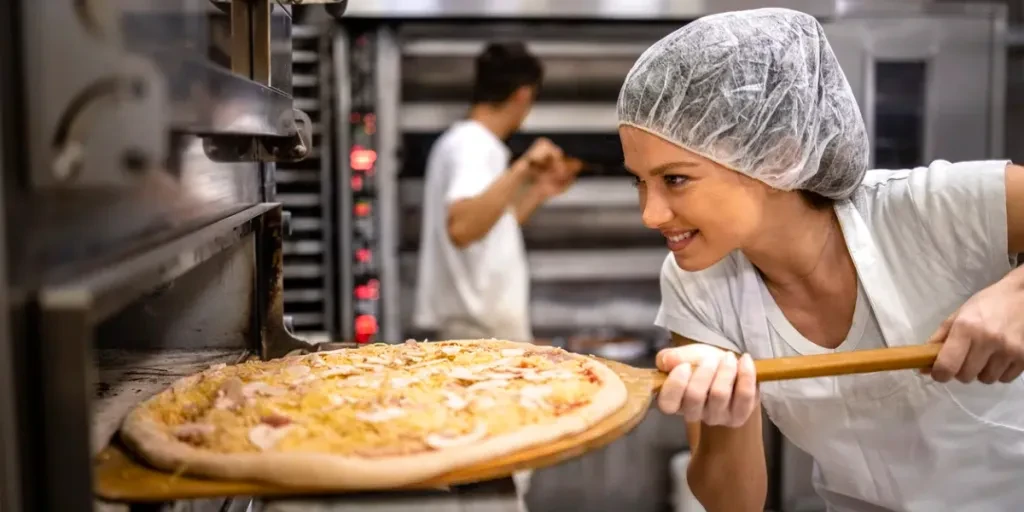
Routine Maintenance Practices
Routine maintenance is essential to ensure the longevity and optimal performance of pizza shop equipment. Regular cleaning and servicing can prevent the buildup of grease and grime, which can cause equipment to malfunction. For example, pizza ovens should be cleaned daily to remove food residues and prevent carbon buildup, which can affect cooking efficiency and flavor.
Scheduled inspections are crucial to identify and address potential issues before they escalate. Technicians should check for wear and tear, loose connections, and other signs of damage. For instance, dough mixers should be inspected for motor function and lubrication levels to ensure smooth operation. Regular maintenance not only extends the lifespan of the equipment but also ensures consistent quality in food preparation.
Documentation of maintenance activities is important for tracking the equipment’s condition and performance. Keeping detailed records of cleaning schedules, inspections, and repairs can help in identifying recurring issues and planning for replacements. This proactive approach can save time and money by preventing unexpected breakdowns and ensuring the equipment remains in top working condition.
Importance of Warranty and Service Agreements
Warranties and service agreements provide a safety net for pizza shop owners, protecting them from unexpected repair costs. Most commercial kitchen equipment comes with a manufacturer’s warranty that covers defects and malfunctions for a specified period. For example, a commercial pizza oven may come with a one-year warranty on parts and labor, ensuring that any issues within this period are addressed at no additional cost.
Service agreements extend the benefits of warranties by offering ongoing maintenance and support. These agreements can include regular inspections, priority service, and discounted repair rates. For instance, a service agreement for a refrigeration unit might include bi-annual inspections and 24/7 emergency repair services. This ensures that the equipment is always in optimal condition and reduces downtime in case of malfunctions.
Investing in extended warranties and service agreements can provide peace of mind and financial security. They ensure that any issues are promptly addressed by qualified technicians, minimizing disruptions to the business. Additionally, these agreements often include preventive maintenance, which can extend the lifespan of the equipment and enhance its performance, ultimately saving money in the long run.
Tips for Extending Equipment Lifespan
Proper usage and care are fundamental to extending the lifespan of pizza shop equipment. Staff should be trained on the correct operation of each piece of equipment to prevent misuse and damage. For example, overloading a dough mixer can strain the motor and reduce its lifespan. Clear operating procedures and regular training sessions can help in maintaining the equipment’s integrity.
Regular cleaning and maintenance are crucial for preventing wear and tear. Equipment should be cleaned according to the manufacturer’s guidelines to avoid damaging sensitive components. For instance, using harsh chemicals on stainless steel surfaces can cause corrosion. Instead, mild detergents and soft cloths should be used to maintain the equipment’s appearance and functionality.
Timely repairs and replacements of worn-out parts can prevent further damage to the equipment. For example, replacing a worn-out gasket in a refrigerator can prevent leaks and maintain optimal cooling efficiency. Keeping an inventory of spare parts and having a reliable service provider can ensure that repairs are carried out promptly, minimizing downtime and extending the equipment’s lifespan.
Future Trends in Pizza Shop Equipment

Technological Innovations
Technological advancements are revolutionizing pizza shop equipment, enhancing efficiency and customer experience. One notable innovation is the use of conveyor ovens with advanced heat distribution systems. These ovens ensure consistent cooking by using infrared technology and can cook a pizza in as little as 90 seconds, significantly reducing wait times.
Automation is another trend transforming pizza shop operations. Automated pizza makers can handle tasks such as dough stretching, topping application, and baking with minimal human intervention. For example, the Pizzaiola robot can prepare up to 100 pizzas per hour, ensuring consistency and freeing up staff for other tasks. This technology not only improves efficiency but also reduces labor costs.
Integration with digital platforms is also becoming common in modern pizza shops. Smart ovens and refrigerators can be connected to IoT (Internet of Things) systems, allowing remote monitoring and control. For instance, temperature settings can be adjusted via a smartphone app, ensuring optimal conditions even when the staff is not on-site. This connectivity enhances operational efficiency and ensures food safety.
Smart Kitchen Equipment
Smart kitchen equipment is gaining traction in the pizza industry, offering enhanced control and efficiency. Smart ovens, for example, come with programmable settings and remote monitoring capabilities. These ovens can store multiple cooking profiles, allowing for precise temperature and time control for different pizza types. This ensures consistent quality and reduces the risk of overcooking or undercooking.
Refrigeration units with smart technology are also becoming popular. These units can monitor temperature and humidity levels in real-time, sending alerts if conditions deviate from the set parameters. This ensures that ingredients are stored in optimal conditions, reducing spoilage and waste. Additionally, smart refrigerators can track inventory levels and automatically reorder supplies when stock is low, streamlining inventory management.
Smart kitchen equipment also includes advanced point-of-sale (POS) systems that integrate with kitchen operations. These systems can track orders, manage inventory, and provide real-time sales data. For example, a POS system can send orders directly to the kitchen display system, reducing order processing time and minimizing errors. This integration enhances overall efficiency and improves customer satisfaction.
Sustainable and Eco-Friendly Solutions
Sustainability is a growing focus in the pizza industry, with equipment manufacturers developing eco-friendly solutions. Energy-efficient ovens and refrigerators are designed to reduce energy consumption and lower carbon footprints. For instance, Energy Star-rated pizza ovens use advanced insulation and heat recovery systems to minimize energy usage, resulting in significant cost savings and environmental benefits.
Water-saving equipment is also becoming essential in sustainable pizza shops. Dishwashers with low water consumption and high-efficiency spray arms can reduce water usage by up to 50%. Additionally, equipment that supports recycling and waste reduction, such as composting units and waste compactors, helps in managing kitchen waste more effectively. These solutions contribute to a greener operation and can attract environmentally conscious customers.
The use of sustainable materials in equipment manufacturing is another trend. Equipment made from recycled or recyclable materials reduces environmental impact. For example, stainless steel, which is highly recyclable, is commonly used in kitchen equipment. By choosing equipment with sustainable features, pizza shops can reduce their environmental footprint and promote a positive brand image.
Making the Final Decision
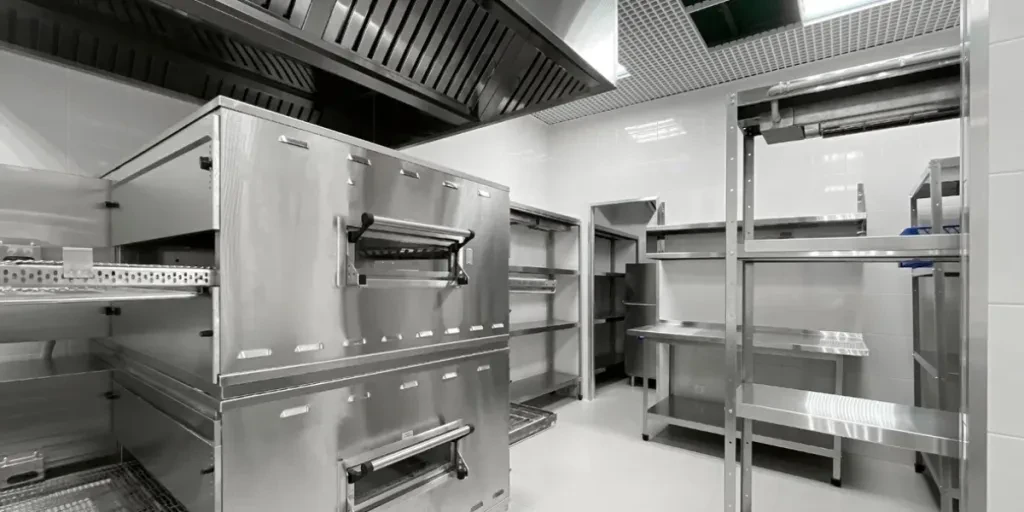
The pizza shop equipment market is evolving rapidly, driven by advancements in technology, energy efficiency, and sustainability. With innovations like smart kitchen solutions and automated systems, operators can enhance productivity and reduce operational costs. As the market continues to grow, investing in the right equipment is essential for staying competitive. Explore your options today to equip your pizza shop for future success!




